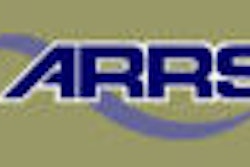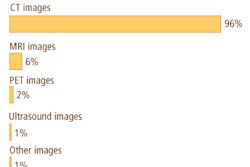The day-to-day business of radiology practice management is conducted through the use of benchmarks, comparative data, objectives, indicators, and targets. More often than not, these elements and their corresponding figures are located in disparate reports. According to Verlon Salley, a radiology administrator with ProScan Imaging in Cincinnati, creating a practice scorecard that places this information in one location gives managers a balanced view of major performance indicators.
"Strategically managing with scorecards assists administrators with decision-making and forecasting through the use of a tool that presents quantitative and qualitative data," he said.
Salley, who spoke at the American Healthcare Radiology Administrator (AHRA) Imaging Center Administrator's conference this October in Phoenix, cited three strategic advantages that scorecards provide. They allow the measurement and alignment of an organization's vision, mission, and strategic plan. They improve the capability to predict a practice's challenges and opportunities, and they proactively handle the public's increasing awareness of and demand for quality information.
"If you can't measure it, you can't manage it," he said.
Salley's scorecards have four performance measures printed out in quadrants: quality, financial performance, operational effectiveness, and workplace excellence. He presented quarterly scorecards as examples, but noted that a practice could generate them on a monthly or even weekly basis. He recommended that administrators deliver results to their staff monthly, and to practice managers quarterly.
Quality
The quality element of Salley's scorecard measures the degree of excellence achieved by the practice. The four elements of quality that he offered were patient satisfaction, report turnaround time, patient safety, and redos and callbacks.
To assess patient satisfaction, Salley's group conducts frequent patient satisfaction surveys. Questionnaires assess the purpose of patients' visits; the referral process; scheduling; staff, operations, and care; and overall performance, as well as solicit patient comments. The purpose section ascertains the modalities for which patients were referred, and whether they are repeat customers of the facility.
The referral process section inquires if patients were offered a choice of locations, what the choices were, if they knew why their physician recommended the facility, and why they selected that particular practice location. The scheduling portion of the survey queries patients as to who scheduled the appointment and if they got the appointment they desired. It also requests patients to rate the overall process.
Staff, operations, and care metrics are derived from a series of questions and ratings on elements such as center cleanliness, technologist patient care, timeliness of appointment, and the knowledge and professionalism of front desk personnel regarding patient issues, including billing questions. The overall performance component of the survey asks patients for their overall rating of their experience at the center, and offers them an opportunity to suggest improvement areas for the practice.
Salley breaks his report turnaround time out by modality, then calculates the total number of procedures and outliers, the average exam cycle time, the average time to dictation from the end of the exam, the average dictation time, and the average transcription time. These elements are then totaled for an average report turnaround time per modality and assigned a letter grade from A to F by Salley.
Patient safety is calculated through safety log audits, patient fall incidents, the number of infiltrates and extravasations, and a quality care control report conducted by the facility. Redos and callbacks are ascertained from the RIS and PACS logs, Salley said.
The quality analysis quadrant of the scorecard provides managers with a snapshot of overall patient satisfaction, as well as opportunity areas for the practice to better the patient's experience. The report turnaround time section, by breaking out average table times, shows opportunities and bottlenecks for the group. The patient safety metrics show areas that need special attention and risk management, while the redos and callbacks point to areas that can benefit from further training and education.
Financial performance
For Salley, the financial performance quadrant of his scorecard contains four main elements: the operating income divided by revenues to show the group's operating margin percentage; cost divided by unit of service (UOS); man hours divided by UOS; and specific procedures, such as cardiac MRI or virtual colonoscopy divided by the total procedure volume of the practice.
According to Salley, the operating margin shows him the percentage of profit for each dollar of sales, and the cost divided by UOS provides him the cost per procedure/scan performed. The man-hours divided by UOS demonstrates how productive his full-time equivalent (FTE) model is, and the specific procedure area shows how the group's product lines are growing.
Operational effectiveness
To assess operational effectiveness of his practice, Salley's metrics include the actual and budgeted volume, the year-to-date variance, capacity management, and appointment availability.
Salley breaks out his actual and budgeted volume data on a modality unit by modality unit monthly basis. For example, he collects procedure volume data on each MR unit in the facility every month, totals it, and compares the actual volume with the budgeted volume to establish a positive or negative variance. This data is also compiled on a year-to-date basis, which provides a snapshot of how the practice is doing compared with the previous year.
To establish capacity management metrics, Salley tracks the total number of scheduled patients for each modality in the practice, as well as the number of patients preregistered for each piece of equipment on a daily basis. In addition, he notes the number of cancelled appointments, reschedules, and no-shows. From this data, he is able to calculate the percentage of preregistered patients for each modality on a daily, weekly, and monthly basis.
The capacity snapshot, according to Salley, provides him a metric for patient throughput and capacity opportunities via cancellations and reschedules, and offers a starting point for a more thorough analysis of practice workflow.
Appointment availability, measured in terms of days out to schedule an appointment for each modality, alerts managers to any backlog trends in the practice. This data may lead a practice to further drill down its protocols and prep time for patients to maximize the efficiency of the modality, he said. Salley also noted that this information could possibly be used for program development and capital equipment purchase assessments.
Workplace excellence
Five elements make up the workplace excellence quadrant of Salley's practice scorecard: turnover rate, retention rate, employee satisfaction, downtime rate, and employee performance evaluation results.
According to Salley, the turnover rate shows the number of employees lost during the measurement period, and the retention rate shows the number of employees retained during the time period. Employee satisfaction surveys are conducted quarterly, and Salley incorporates this data into his scorecard. This element can reflect the practice's overall delivery of service and the employee performance evaluation results, while the downtime report shows the quality of maintenance and service on a practice's modalities, he said.
Creating a practice management scorecard is not without difficulties, Salley said. For example, a manager could become bogged down by following too many numbers, he said. Salley advocates using the practice's RIS to automatically generate as many of the scorecard reports as possible. In addition, he noted that once scorecards are accepted by the practice, administrators may be pressured to make the numbers.
"If you track the numbers, you will be held to the numbers," he said.
Salley believes that scorecards are most successful when all levels of the organization buy into the process and take responsibility for the data and results. He stressed that it is imperative that all scorecard information, tools, and drivers are correct. Once these objectives are achieved, managers are able to use the device to have a balanced view of the major perspectives of performance, Salley said. He also suggested creating a comments section for each data-gathering element, so that usual and unusual occurrences such as staff meetings or missing deliveries of consumables can be noted.
"Utilize the scorecards to create action plans and to follow through," he said.
By Jonathan S. Batchelor
AuntMinnie.com staff writer
November 2, 2005
Related Reading
Service blueprinting maps path to excellence, August 26, 2005
Rad workload shows double-digit increase, September 22, 2005
Healthcare IT delivers market advantage, June 9, 2005
Claims denial management improves practice, bottom line, June 8, 2005
Web-based workflow and reporting systems keep imaging on track, March 10, 2005
Copyright © 2005 AuntMinnie.com



















